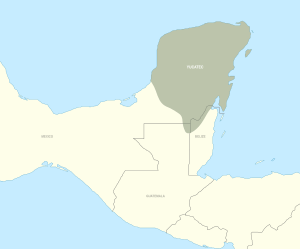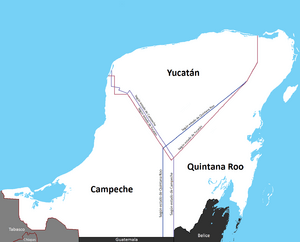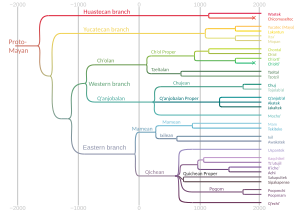Yucatec Maya language
Quick facts for kids Yucatec Maya |
||||
|---|---|---|---|---|
| mayaʼ tʼàan máayaʼ tʼáan |
||||
| Native to | Mexico, Belize | |||
| Region | Yucatán, Quintana Roo, Campeche | |||
| Native speakers | 800,000 including 775,000 in Mexico (2020 census)e25 | |||
| Language family |
Mayan
|
|||
| Official status | ||||
| Official language in | Mexico | |||
| Regulated by | INALI | |||

Location of Yucatec Mayan speaking areas on the Yucatan Peninsula
|
||||
|
||||
Yucatec Maya is a language spoken by the Maya people in the Yucatán Peninsula of Mexico and northern Belize. People who speak this language often simply call it "Maya." There are also many Yucatec Maya speakers living in San Francisco, USA.
Contents
What is Yucatec Maya?
Linguists, who are scientists who study languages, added "Yucatec" to the name. This helps them tell it apart from other Mayan languages like Kʼicheʼ. So, "Yucatec Maya" is a more scientific name. But native speakers usually just say "Maaya" or "maayaʼ tʼàan" in their own language. When they speak Spanish, they call it (el) maya.
Today, Yucatec Maya is still the main language for many people. You can find speakers in the Mexican states of Yucatán, parts of Campeche, Tabasco, Chiapas, and Quintana Roo. About 800,000 people speak it in this area. In Belize, about 2,500 people spoke Yucatec Maya in 2010.
History of the Language
Yucatec Maya is part of the Yucatecan group of the Mayan languages family. This group includes four languages:
- Itza
- Mopan
- Yucatec Maya
- Lacandon
All Mayan languages are believed to come from an older language. This language was spoken about 5,000 years ago. It is called Proto-Mayan.
The Maya civilization was very strong between 200 and 800 AD. They made amazing progress in technology. They created a complex system for numbers and hieroglyphs (picture writing). Later, they moved to the Yucatán peninsula. In the 12th and 13th centuries, three important cities worked together: Uxmal, Chichen Itza, and Mayapan. This was a time of peace and great art and learning. But then wars started, and progress slowed down. By the 15th century, the Maya cities were abandoned.
Spanish Arrival
The explorer Christopher Columbus met Maya traders in 1502. This was off the coast of Yucatán. But he did not land there. The first Spaniards to land on Yucatán arrived by accident. They were survivors of a shipwreck in the Caribbean. The Maya sacrificed most of these men. Only two survived: Gerónimo de Aguilar and Gonzalo Guerrero.
In 1519, Aguilar joined Hernán Cortés on his journey to Cozumel island. He also helped in the conquest of central Mexico. Guerrero became a legend. He married local women and wore traditional clothes. He even fought against the Spanish.
The Spanish tried to conquer Yucatán for 24 years. This involved three long wars.
As more Spanish settlers arrived, they started large farms in the 18th century. These farms grew maize (corn) and raised cattle. The wealthy Spanish lived in large estates called haciendas. They sent natural resources out of the country. The Maya people were under Spanish rule from 1542 to 1821.
Language Changes During Colonial Times
During the Spanish rule, missionaries wanted to change Yucatec Maya. They wanted to use it to teach the Maya about the Catholic Church. They also wanted to control the Maya people.
Spanish missionaries translated Catholic religious books into Yucatec Maya. They also created new words for Catholic ideas. This process changed the language. The missionaries tried to stop Maya religious practices. They also destroyed Maya written works. But Maya speakers used this changed language for their own purposes. They resisted Spanish control. The oldest written records in this changed Maya language were made by Maya notaries. These were written between 1557 and 1851. You can find these works in libraries and archives today.
How Yucatec Maya Sounds
Yucatec Maya has special sounds called ejective consonants. These are sounds like /pʼ/, /tʼ/, and /kʼ/. They are made with a quick "popping" sound. You write them with an apostrophe after the letter. For example, tʼàan means "speech," while táan means "forehead."
Yucatec Maya is one of only three Mayan languages that uses tone. This means the pitch of your voice changes the meaning of a word. It has short vowels and long vowels. Long vowels can have a high tone or a low tone. A high tone might be shown with an acute accent (like íi), and a low tone with a grave accent (like ìi).
Consonants
| Lip | Alveolar | Palatal | Velar | Glottal | ||
|---|---|---|---|---|---|---|
| Nasal | m ⟨m⟩ | n ⟨n⟩ | ||||
| Implosive | ɓ ⟨b⟩ | |||||
| Plosive | plain | p ⟨p⟩ | t ⟨t⟩ | k ⟨k⟩ | ʔ ⟨ʼ⟩ | |
| ejective | pʼ ⟨pʼ⟩ | tʼ ⟨tʼ⟩ | kʼ ⟨kʼ⟩ | |||
| Affricate | plain | ts ⟨tz⟩ | tʃ ⟨ch⟩ | |||
| ejective | tsʼ ⟨tzʼ⟩ | tʃʼ ⟨chʼ⟩ | ||||
| Fricative | s ⟨s⟩ | ʃ ⟨x⟩ | x ⟨j⟩ | h ⟨h⟩ | ||
| Approximant | w ~ v ⟨w⟩ | l ⟨l⟩ | j ⟨y⟩ | |||
| Flap | ɾ ⟨r⟩ | |||||
Vowels
Yucatec Maya has five basic vowel sounds:
| Front | Back | |
|---|---|---|
| Close | i | u |
| Mid | e | o |
| Open | a | |
These vowels can be short or long. Long vowels can also have different tones or a "creaky" sound. For example:
| Short, normal tone | Long, low tone | Long, high tone | Creaky voiced, long, high tone |
|---|---|---|---|
| pik 'eight thousand' | miis 'cat' | míis 'broom; to sweep' | niʼichʼ 'to get bitten' |
Word Stress
Words in Yucatec Maya usually have stress on the first syllable with a long vowel. If there are no long vowels, the last syllable is stressed. Words borrowed from other languages often keep their original stress.
Grammar Basics
Like most Mayan languages, Yucatec Maya usually starts sentences with the verb. The order of words can be Verb-Object-Subject (VOS) or Verb-Subject-Object (VSO). VOS is the most common.
Yucatec Maya does not use tense like English (past, present, future). Instead, it uses aspect to show when something happened. This means it focuses on whether an action is finished or still happening.
How Yucatec Maya is Written
The Maya people were able to read and write long before Europeans arrived. They used a system called Maya script. This writing system was used for their ancient language.
Today, Yucatec Maya is written using the Latin script. This was brought by the Spanish in the 16th century. The way it was written back then was based on Spanish spelling rules. For example, the letter x was used for a "sh" sound.
Common Phrases
Here are some common phrases in Yucatec Maya:
| Yucatec Maya | English | ||
|---|---|---|---|
| Standard pronunciation |
Pronunciation of western Yucatán, northern Campeche and Central Quintana Roo |
Normal translation | Literal translation |
| Bix a beel? | Bix a beej? | How are you? | How is your road? |
| Maʼalob, kux teech? | Good, and you? | Not bad, as for you? | |
| Bey xan teen. | Same with me. | Thus also to me. | |
| Tuʼux ka bin? | Where are you going? | Where do you go? | |
| T(áan) in bin xíimbal. | I am going for a walk. | ||
| Bix a kʼaabaʼ? | What is your name? | How are you named? | |
| In kʼaabaʼeʼ Jorge. | My name is Jorge. | My name, Jorge. | |
| Jach kiʼimak in wóol in wilikech. | Pleased to meet you. | Very happy my heart to see you. | |
| Baʼax ka waʼalik? | What's up? | What (are) you saying? What do you say? |
|
| Mix baʼal. | Mix baʼaj. | Nothing. Don't mention it. |
No thing. |
| Bix a wilik? | How does it look? | How you see (it)? | |
| Jach maʼalob. | Very good. | Very not-bad | |
| Koʼox! | Let's go! (For two people – you and I) | ||
| Koʼoneʼex! | Let's go! (For a group of people) | ||
| Baʼax a kʼáat? | What do you want? | ||
| (Tak) sáamal. | Aasta sáamaj. | See you tomorrow. | Until tomorrow. |
| Jach Dios boʼotik. | Thank you. God bless you very much. |
Very much God pays (it). | |
| Wakax | Cow | Cow | |
Yucatec Maya in Modern Culture
Yucatec Maya is used in many modern ways:
- Radio stations run by the CDI play programs in Yucatec. These stations are in Xpujil, Campeche, Felipe Carrillo Puerto, Quintana Roo, and Peto, Yucatán.
- The 2006 movie Apocalypto, directed by Mel Gibson, was filmed entirely in Yucatec Maya. A Maya speaker named Hilario Chi Canul translated the script. He also helped the actors learn the language.
- In the video game Civilization V: Gods & Kings, the Maya leader Pacal speaks Yucatec Maya.
- In 2012, many Yucatec Maya speakers helped translate the Mozilla browser and MediaWiki software (used by Wikipedia) into their language. This was part of the Google Endangered Languages Project.
- Baktun, the first ever Maya telenovela (a type of TV soap opera), started in 2013.
- Jesús Pat Chablé is known as one of the first Maya-language rappers and music producers.
- In the 2018 video game Shadow of the Tomb Raider, characters in the Paititi region speak Yucatec Maya.
- A modern edition of the bible, the New World Translation of the Holy Scriptures, was released in Maya in 2019. It is available for free online and in print.
- In December 2019, the government of Yucatán decided that Maya language must be taught in schools.
- In the 2022 movie Black Panther: Wakanda Forever, the underwater kingdom of Talokan and its king, Kukulkan, speak Yucatec Maya.
See also
 In Spanish: Idioma maya para niños
In Spanish: Idioma maya para niños
- Yucatec Maya Sign Language



